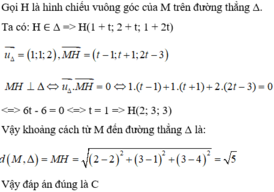
Hãy nhập câu hỏi của bạn vào đây, nếu là tài khoản VIP, bạn sẽ được ưu tiên trả lời.


Phương trình đường thẳng dạng tổng quát:
\(x+2y-5=0\)
Khoảng cách: \(d=\dfrac{\left|3-4-5\right|}{\sqrt{1^2+2^2}}=\dfrac{6}{\sqrt{5}}\)

\(1/\)
\(M\left(3;5\right);d:x+y+1=0\)
\(\)Gọi khoảng cách từ M đến d là \(l\)
\(l\left(M;d\right)=\dfrac{\left|x_M+y_M+1\right|}{\sqrt{1^2+1^2}}=\dfrac{\left|3+5+1\right|}{\sqrt{1^2+1^2}}=\dfrac{9\sqrt{2}}{2}\)
\(M\left(2;3\right);d:\left\{{}\begin{matrix}x-2t\\y=2+3t\end{matrix}\right.\)
d qua \(M\left(2;3\right)\) có \(VTCP\overrightarrow{u}=\left(-2;3\right)\Rightarrow VTPT\overrightarrow{n}=\left(3;2\right)\)
\(PTTQ\) của \(\Delta:3\left(x-2\right)+2\left(y-3\right)=0\)
\(\Rightarrow3x-6+2y-6=0\)
\(\Rightarrow3x+2y-12=0\)
Gọi khoảng cách từ M đến d là \(l\)
\(l\left(M;d\right)=\dfrac{\left|3.x_M+2.y_M-12\right|}{\sqrt{3^2+2^2}}=\dfrac{\left|3.2+2.3-12\right|}{\sqrt{3^2+2^2}}=0\)

a) Ta có: \(\Delta \):\(\frac{x}{{ - 4}} + \frac{y}{2} = 1 \Leftrightarrow x - 2y + 4 = 0\)
Vậy khoảng cách từ O đến \(\Delta \) là: \(d\left( {O;\Delta } \right) = \frac{{\left| {1.0 - 2.0 + 4} \right|}}{{\sqrt {{1^2} + {2^2}} }} = \frac{{4\sqrt 5 }}{5}\)
b) Lấy \(M\left( {0;1} \right) \in {\Delta _1}\)
Suy ra: \(d\left( {{\Delta _1},{\Delta _2}} \right) = d\left( {M,{\Delta _2}} \right) = \frac{{\left| {0 - 1 - 1} \right|}}{{\sqrt {{1^2} + {{\left( { - 1} \right)}^2}} }} = \sqrt 2 \)

Gọi \(M\left(2+2t;3+t\right)\)
M có tọa độ nguyên \(\Leftrightarrow t\) nguyên
\(\overrightarrow{AM}=\left(2+2t;2+t\right)\) \(\Rightarrow AM=\sqrt{\left(2+2t\right)^2+\left(2+t\right)^2}=5\)
\(\Leftrightarrow5t^2+12t-17=0\Rightarrow\left[{}\begin{matrix}t=1\\t=-\dfrac{17}{5}\left(loại\right)\end{matrix}\right.\)
\(\Rightarrow M\left(4;4\right)\)

a) Khoảng cách từ điểm A đến đường thẳng \(\Delta \) là: \(d\left( {A,\Delta } \right) = \frac{{\left| {0 - 2 - 4} \right|}}{{\sqrt {{1^2} + {1^2}} }} = 3\sqrt 2 \).
b) Ta có: \(\overrightarrow {{n_a}} = \overrightarrow {{n_\Delta }} = \left( {1;1} \right)\). Phương trình đường thẳng a là:
\(1\left( {x + 1} \right) + 1\left( {y - 0} \right) = 0 \Leftrightarrow x + y + 1 = 0\)
c) Ta có: \(\overrightarrow {{u_a}} = \overrightarrow {{n_\Delta }} = \left( {1;1} \right)\).Từ đó suy ra \(\overrightarrow {{n_b}} = \left( {1; - 1} \right)\). Phương trình đường thẳng b là:
\(1\left( {x - 0} \right) - 1\left( {y - 3} \right) = 0 \Leftrightarrow x - y + 3 = 0\)

\(d\left(A;\Delta\right)=\dfrac{\left|-3\left(m-2\right)+9\left(m+1\right)-5m+1\right|}{\sqrt{\left(m-2\right)^2+\left(m+1\right)^2}}\)
\(=\dfrac{\left|m+16\right|}{\sqrt{2m^2-2m+5}}=k\Rightarrow\left(m+16\right)^2=k^2\left(2m^2-2m+5\right)\)
\(\Rightarrow\left(2k^2-1\right)m^2-2\left(k^2+16\right)m+5k^2-256=0\)
\(\Delta'=\left(k^2+16\right)^2-\left(2k^2-1\right)\left(5k^2-256\right)\ge0\)
\(\Rightarrow0\le k^2\le61\) \(\Rightarrow k^2_{max}=61\) khi \(m=\dfrac{7}{11}\)

Lời giải:
$x=-2+t; y=1+2t$
$\Rightarrow 2x-y=2(-2+t)-(1+2t)=-5$
$\Leftrightarrow 2x-y+5=0$
Khoảng cách từ điểm $M$ đến $(\Delta)$ là:
\(\frac{|2.3-(-1)+5|}{\sqrt{2^2+(-1)^2}}=\frac{12\sqrt{5}}{5}\)